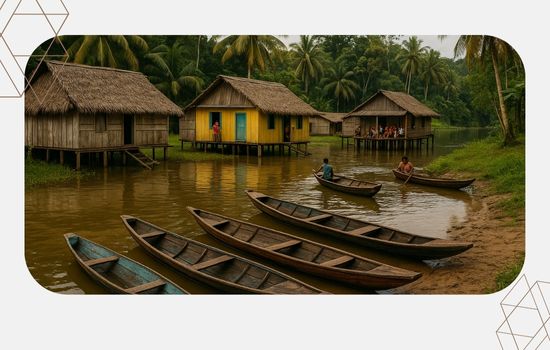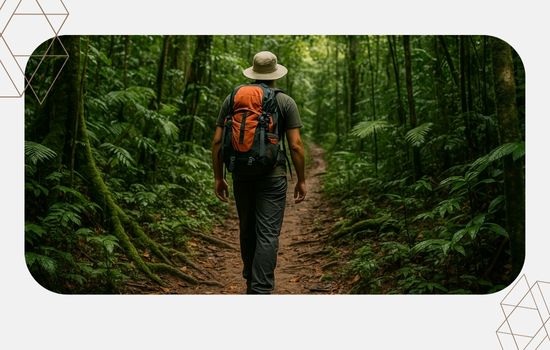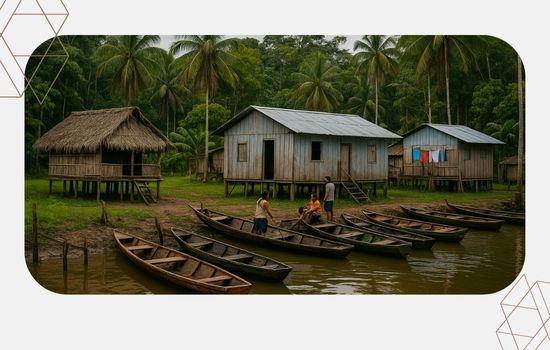Advertisements
Explore the planet's most impressive jungle with respect, safety, and reliable digital support.
The Amazon is a world unto itself. It covers millions of hectares of tropical rainforest, is home to thousands of unique animal and plant species, and is home to hundreds of communities that live in harmony with nature.
Traveling through this region isn't like visiting a traditional tourist town. It requires preparation, respect, and a touch of technology to make every step of the way easier.
In this comprehensive guide, you'll learn everything you need to explore the Amazon in a responsible, safe, and enriching way.
We'll show you how to plan your trip, what to bring, how to interact with local communities, and what to do in unexpected situations.
Advertisements
In addition, you'll learn about two mobile apps that will become your allies during this adventure.
Why explore the Amazon?
The Amazon is not just a jungle. It's living history, pure science, ancient culture, and a constant call to introspection.
Traveling through the Amazon also means disconnecting from the modern world and reconnecting with what's essential.
Those who venture to explore it discover:
- A lush and powerful nature
- Communities with ancestral knowledge
- Physical and mental challenges that strengthen character
- A new way of seeing life
But for this experience to be positive, it is necessary to prepare with awareness and respect.
Technology can be a great ally if used correctly. This is where this practical guide comes in.

Before you go: planning and preparation
Understanding the territory
The Amazon region spans nine South American countries.
Brazil is home to about 60% of the total Amazon rainforest, but it is also found in Colombia, Peru, Bolivia, Venezuela, Ecuador, Guyana, Suriname, and French Guiana.
Choosing the exact area you want to visit is crucial. Some areas are more accessible, while others can only be reached by plane or boat.
The main entry cities are usually:
- Manaus (Brazil)
- Leticia (Colombia)
- Iquitos (Peru)
- Puerto Maldonado (Peru)
- Belém and Santarém (Brazil)
Good planning will save you time, money, and unnecessary risks.
Read also:
It will stay in the same place!
Documentation and vaccinations
Before entering any part of the Amazon, it is essential to:
- Have the yellow fever vaccine applied at least 10 days in advance
- Carry personal documentation and copies protected against moisture
- Check if you need a visa or special permits depending on the area you are visiting.
Some protected areas require prior permits. Inquire with local agencies or directly with communities that allow tourist entry.
Smart luggage
Packing for the Amazon isn't the same as packing for a beach vacation. Functionality, lightness, and protection from moisture, insects, and sudden changes in weather are key.
The basics that can't be missing:
- Waterproof backpack with good capacity
- Light but long-sleeved clothing (sun and insect protection)
- Strong, skin-safe insect repellent
- Boots or waterproof footwear
- Hat or cap with sun protection
- Raincoat or poncho
Additionally, it is recommended to include a headlamp, external battery, dry bag for documents, and portable water filter.
Useful Technology: Your Digital Allies in the Jungle
Although the Amazon does not have constant internet coverage, there are applications that work offline and can be vital.
iOverlander: Your Reliable Off-Grid Map
iOverlander It is an application created by travelers for travelers.
Its purpose is to help locate useful points such as lodging, safe camping spots, gas stations, supply stores, and routes suggested by other explorers.
It is constantly updated with real-life experiences and works offline, making it ideal for remote areas.
You can filter places by category, read reviews, and save favorites.

Offline Survival Manual: Survival in Your Pocket
This free app is a complete survival encyclopedia. Download it before your trip and access information such as:
- Techniques for lighting a fire in a humid environment
- Water filtration and purification
- Edible and poisonous plants
- Basic first aid
- Construction of improvised shelters
Offline Survival Manual It doesn't take up much space and can make a difference in a critical situation.
Cultural connection: respect and learning with local communities
The Amazon is inhabited by hundreds of indigenous peoples and riverside communities who maintain their culture alive. Many offer community-based tourism as a means of income and preservation.
How to respectfully visit these communities?
- Always ask permission before taking photos or entering a village.
- Learn some basic words in their language or show genuine interest
- Participate in your activities with humility and without judgment
- Value your artisanal products, buying them directly
- Listen to their stories and perspectives without trying to impose your vision.
These experiences are not only culturally valuable, but also strengthen sustainable tourism and foster genuine human exchange.
Basic Survival: Tips for Moving Safely
Entering the jungle requires constant attention. It's not a casual stroll. Here are some practical tips that have saved more than one traveler.
Don't walk alone
Never enter jungle trails without a guide or companion. The routes may seem obvious, but the vegetation changes quickly and it's easy to get lost.
Mark your path
If you decide to take short hikes, leave visible markers with branches or tape on trees. You can also use your phone's GPS if you've previously downloaded offline maps.
Avoid hours of intense sun
Heat can quickly dehydrate you. The best times to walk are between 6 a.m. and 10 a.m., and between 4 p.m. and 6 p.m. Always carry filtered water.
Recognizes sounds and footprints
Learning to distinguish the sounds of the jungle can help you avoid unexpected encounters. Listen carefully and don't use headphones.
Water only if it is purified
Even if it appears clean, river water can contain bacteria or parasites. Use purification tablets, filters, or boil it before drinking.
Food in the jungle: what to bring and what to avoid
Eating well is essential to maintaining energy during hikes and demanding days. However, it's key to choose light, long-lasting, and easy-to-prepare foods.
Recommended options:
- Dried fruits and nuts
- Energy bars
- Salty crackers
- Hydration powders with electrolytes
- Dehydrated foods (light and long-lasting)
Avoid perishable foods, heavy containers, or containers that are at risk of breaking and attracting insects.

The Amazonian climate and how to adapt
The Amazon's humid tropical climate has two main seasons: the rainy season (December to May) and the dry season (June to November). Both have advantages and disadvantages.
Dry season:
- Best for long hikes and firm trails
- Greater presence of mosquitoes
- Possibility of river beaches
Rainy season:
- Ideal for navigating swollen rivers
- Denser and more colorful vegetation
- Muddy trails with reduced visibility
Always check local weather forecasts and adjust your equipment to the expected weather.
Unique experiences that you will only live in the Amazon
Exploring the Amazon isn't just about survival. It's also about wonder, spirituality, and connection with life.
Some unforgettable experiences include:
- Watch pink dolphins swimming in dark rivers
- Sleeping in a hammock under a sky full of stars
- Try exotic fruits such as arazá, copoazú or camu camu
- Listen to bird songs that don't exist anywhere else
- Participate in ancestral rituals with local shamans
Every step in the jungle is an opportunity to learn about yourself and the planet.
Responsible tourism: your role as a visitor
Beyond personal enjoyment, when traveling through the Amazon you have a responsibility.
You can choose to be part of the solution by supporting practices that protect the ecosystem and value local culture.
How to be a conscious traveler:
- Avoid using single-use plastics
- Do not buy wild animals or plants
- Don't leave trash, not even biodegradable
- Use sunscreens and ecological repellents
- Support local guides and businesses
The jungle needs allies, not indifferent tourists.
Recommended apps for your trip
You don't need a lot of mobile data to stay safe and informed. Here are the two key apps mentioned above, with direct links to the Play Store:
Both work offline and are lightweight. Download them before your trip and be sure to explore them to familiarize yourself with their features.
Conclusion: The most transformative adventure of your life
Traveling through the Amazon is a privilege. Not everyone has the opportunity to walk through the world's largest rainforest, experience living cultures, touch ancient trees, and discover that life can be simple, yet extraordinary.
With preparation, respect, and the help of technology, your trip will not only be safe, but deeply enriching. The jungle awaits you with all its secrets, challenges, and gifts.
Download the recommended apps.
Share this guide with those who want to explore with you.
And get ready for the most powerful adventure of your life.



